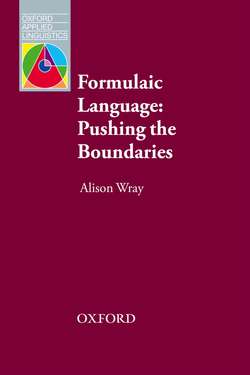Читать книгу Formulaic Language - Alison Wray - Страница 4
На сайте Литреса книга снята с продажи.
PART ONE
Determining boundaries
1
Introduction
Boundaries
ОглавлениеWhen we express ourselves using language, we encode our ideas and attitudes by combining units of form that are associated with meanings. A dominant view in linguistics has been that lexical units are small, and the combinatory rules quite complex. However, there is increasing evidence that some of the units are larger and contain within them tacit complexity that would otherwise be under the remit of the combinatory rules. These larger units still combine with others, but the overall amount of grammatical activity entailed in expressing a complete message is reduced, and some of it is potentially different in kind, compared with that entailed in expressing the same message using smaller units. Since the smaller units also exist, this account simply proposes a greater flexibility in how language is expressed and understood than was previously assumed. Very few, if any, of the explanatory advantages of the ‘small unit’ view are lost, while a number of powerful opportunities arise for explaining patterns observed in language, particularly the complete or relative absence of certain configurations that the small unit view predicts to be possible.
‘Formulaic language’1 is a term used by many researchers to refer to the large units of processing – that is, lexical units that are more than one word long. Although it will be demonstrated later that only certain theories can sustain a fundamental distinction between large and small lexical units, for now it will be adequate, and indeed clearer, to adhere to this preliminary characterization. Research into formulaic language has proliferated in recent years, particularly since computer technology has made it possible to search effectively for examples of recurring multiword strings in large corpora – though opinions differ as to the precise relationship between frequency and formulaicity.
Yet there remain mysteries at the heart of the phenomenon: What exactly is formulaic language? Why do we have it? How does it arise? How can it help with practical matters like learning another language or communicating when one has a language disorder? In my 2002 book, Formulaic Language and the Lexicon (Wray 2002b), I offered possible answers to these and other questions, by locating formulaic language within the larger frame of how we direct our limited language processing capacities towards formulating the messages needed to achieve certain important goals of social interaction. The key proposals developed in that book are recapped in Chapter 2 of this one, as the springboard for new issues that form the focus of the remaining chapters.
This book aims to discover more about the nature and extent of formulaic language by examining a broad range evidence and theory ‘at the boundaries’. Furthermore, in the light of the claim that formulaic language is a linguistic solution to a non-linguistic problem – namely our need to promote and protect ourselves in relation to others (Wray 2002b: 101) – it explores ways in which a greater understanding of the scope of formulaic language might inform our engagement with practical challenges in relation to communication.
The unfolding book addresses inherent tensions regarding the identification, definition, and theoretical modelling of formulaicity. Although the Needs Only Analysis model that underpins this book is not truly falsifiable in the Popperian sense, the attempt is made, nevertheless, to examine the extent of its explanatory power by testing the boundaries of its scope. It is at the boundaries that the real test cases are to be found, and grappling with them provides both valuable insights into the robustness of one’s existing beliefs, and ground rules for evaluating the place of formulaic language in common and unusual linguistic situations.
1
‘Formulaic language’ will be used as the neutral mass (uncountable) noun, while ‘formula’ is used as the neutral count noun (with the plural ‘formulas’, other than in quotations where ‘formulae’ occurs in the original). A new term, ‘morpheme equivalent unit’ (MEU), is introduced in Chapter 2. It is theory-sensitive, and used to refer to the items in the lexicon of an individual speaker or hearer. ‘Formulaic sequence’, a term introduced in my earlier work (Wray 1999, 2002b; Wray and Perkins 2000), has a specific definition (see Chapter 8) and is used in that sense only. In practice this means it is used to refer to items observed in text that are inferred to be MEUs for (usually) large groups of individuals in a speech community. Detailed discussion of definitions is provided in Chapter 8.
